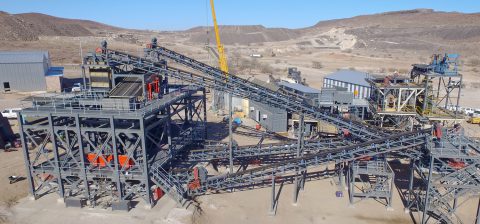SA Mining
Uis In Steady State Production By 2019
Favourable tin prices on the back of robust demand and a forecast of constrained tin availability over the next few years are compelling reasons for investing in the tin market, AfriTin CEO Anthony Viljoen tells SA Mining.
Tin industry body ITRI – the International Tin Research Institute – adds weight to Viljoen’s statement by noting that pressure is building in the tin market owing to a sustained global supply deficit, and that apart from visible stocks at near-historic lows, there is an underlying decline in mine supply.
Given this scenario, the tin junior considers tin to be one of the better performing commodities globally. “Tin is trading at around $20 700/t in a global tin market valued at around $8.23bn. Further, robust long-term fundamentals means that demand for tin will continue for some time,” explains Viljoen.
According to AfriTin’s website, global tin demand is expected to increase by 52% on the back of increasing use for tin in electronic solders and a robust lithium battery market. By 2027, demand for tin will increase by a further 50 000t driven primarily by the lithium battery market, the company says.
Meanwhile, AfriTin – which acquired its tin assets when it de-merged from Bushveld Minerals – believes that its recent listing on the AIM market offers the industry exposure to and first-mover advantage into tin. Bushveld Minerals holds a 17% stake in AfriTin. “The listing gives investors an opportunity into one of the better performing metals currently listed on the AIM market,” says Viljoen, adding that in time, the company would consider a Namibian listing.
AfriTin had looked to raise £4.5m to build its flagship Uis tin project in Namibia.
“There is a widespread view in our market that constraint global tin supply will continue for years to come and having secured the required funding to upscale our pilot plant to steady state production capacity of 60 tonnes per month (tpm) to 70tpm, we believe that we will be well placed to take advantage of any market tightening with our near-production asset.”
Tin projects
AfriTin has two projects – the Uis tin project in Namibia, formerly owned and operated by the South African Iron and Steel Industrial Corporation (Iscor), and the Mokopane project, situated near the town of Mokopane in Limpopo.
The company is eager to bring its flagship Uis tin project, which consists of three project areas in the Erongo region of Namibia, into commercial production as early as March 2019. AfriTin is currently testing a pilot plant on-site.
“The focus is to upscale the pilot plant to produce 1% of global production (5 000tpa) – and while this may seem to be on a relatively small scale, in terms of tin production, it is significant.”
In 2018, AfriTin expects to be operating a second pilot plant, finalising its bankable feasibility study and being cash-generative. The cash will be used to build the larger commercial plant, explains Viljoen.
The Uis project is a pegmatite-hosted tin deposit, one of the largest opencast deposits of its kind, he explains.
Uis was discovered in 1911 and later developed by Iscor as the largest hard-rock tin mine in the world, which produced around 100 000t of tin concentrate over its life of mine (LOM). According to Viljoen, production started in the 1950s and ended in 1990 owing to depressed tin prices.
Most recently though, on the back of strong tin prices and highly attractive long-term fundamentals, rejuvenating the Uis open-pit mine continues to be an appealing option for the junior miner. Apart from having a non-Joint Ore Reserves Committee (JORC)-compliant resource of 73mt, a 30-plus-year LOM and an extremely low stripping ratio, the Uis tin project is located on an extensive mining tenement and allows resource expansion along strike.
“While the Uis project may not be blessed with the Alphamin Bisie Tin Project’s grades of about 4.5%, the opencast project is a highly competitive bulk-scale low-cost project even at the 0.136% tin grades. The deposit is associated with multiple revenue streams, including consisting of tantalite and lithium – new-age metals that are increasing in demand,” states Viljoen.
Located in an “old mining area” and a popular tourist destination, the Uis operation is well placed in terms of infrastructure – it has access to the national grid, is situated close to an established railway siding and is positioned just 200km from Walvis Bay. Apart from an abundance of available underground water for plant use, there is well-established road infrastructure.







 Sign-up and receive the Business Media MAGS newsletter OR SA Mining newsletter straight to your inbox.
Sign-up and receive the Business Media MAGS newsletter OR SA Mining newsletter straight to your inbox.